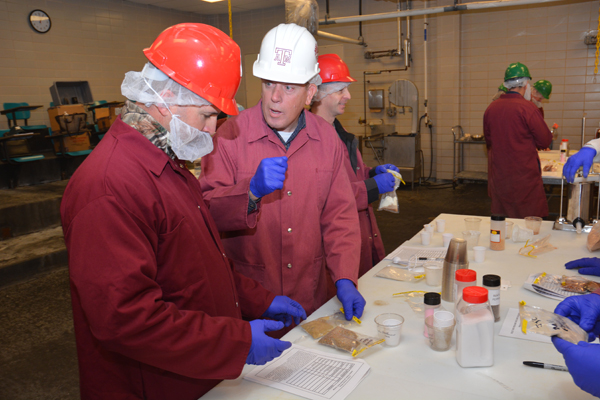- La Feria Community Holds Succesful Business Mixer Event
- Little Nashville to Take Place in Downtown Mercedes
- Lions Basketball Captures District Gold
- La Feria ISD Students Compete in Regional Chess Tournament
- Lions End First Half of 32-4A on a High Note
- La Feria ISD Held Another Successful Parent Conference
- Strong Appearance for Lions at Hidalgo Power Meet
- LFECHS Students Get to Meet Local Actress
- Students Participate in Marine Biology Camp
- Two LFECHS Students Qualify for All-State Band
Creative Sausage Workshop Attracts Interests from All Over Texas
- Updated: February 20, 2015
by Blair Fannin
COLLEGE STATION – From deer hunting enthusiasts to small grocery operators, there was wide interest in a workshop devoted to sausage making held recently at Texas A&M University in College Station.
The workshop was hosted by the Department of Animal Science at Texas A&M. Attendees went home with a wealth of knowledge about making their own sausage, according to organizers.
“We took each of the 31 participants through the grinding and mixing process, teaching them how to make sausage with the actual equipment found in their own kitchen,” said Dr. Wes Osburn, associate professor in the meat science section of the department and a Texas A&M AgriLife Research meat scientist.

Workshop hosted by the Department of Animal Science at Texas A&M drew participants from all over the state and various walks of life. Photo: Texas A&M/Blair Fannin
Dr. Wes Osburn, associate professor in the meat science section of the department of animal science and Texas A&M AgriLife Research meat scientist, discusses spice blending with participants at the recent Creative Sausage Making Workshop in College Station. (Texas A&M AgriLife Extension Service photo by Blair Fannin)
The workshop was open to both beginning and novice sausage makers. Participants were given classroom and hands-on experiences, learning many aspects of sausage making from meat selection, ingredients, casings, stuffing, equipment and processing to the final finished product. Attendees spent part of the workshop in a classroom setting learning about the history of sausage, food safety practices and different seasonings used for various sausage recipes. That was followed by hands-on work in the meat laboratory, including using tabletop grinders, commercial mixers, hand-crank sausage stuffers and natural or artificial casings, Osburn said.
Osburn said the idea for a sausage workshop came about after a discussion with Dr. Davey Griffin, Texas A&M AgriLife Extension Service meat specialist.
“Davey and I got together and decided to develop a creative sausage course,” Osburn said. “We wanted to show the basics of sausage making and use equipment you would find in the kitchen versus the commercial production methods. What we had at the workshop was something you can purchase from various retail stores and use in your home, such as food processors and hand-crank stuffers.”

Additional supporters of the workshop included: Rick Fitzgerald from A.C. Legg Seasonings, Birmingham, Alabama; Maurice Mounce from Alamo Food Equipment Company, Schertz; and Mike Reagan, Dewied Casing Company, San Antonio.
Osburn currently teaches undergraduate and graduate students the concepts and practice of developing quality food systems, and teaches graduate students in the principles and science of processed meats. He also conducts research, working with the meat industry in “helping solve problems, implementing new technology and improving the quality and safety of their products.”
The workshop was open to both beginning and novice sausage makers. Attendees spent part of the workshop in a classroom setting learning about the history o f sausage, food safety practices and different seasonings used for various sausage recipes. That was followed by hands-on work in the meat laboratory, including using tabletop grinders, commercial mixers, hand-crank sausage stuffers and natural or artificial casings. (Texas A&M AgriLife Extension Service photo by Blair Fannin)
Experts note sausage popularity continues to grow with deer hunting enthusiasts as well as small retail grocery operators looking to offer specialty foods for customers.
“Each individual participant had the opportunity to manufacture their own sausages, both smoked and fresh,” Osburn said. “The sausages were vacuum-packaged and placed in Texas A&M styrofoam coolers so they could take their sausage home and share it with their family and friends.
“We are so happy they came and shared their interest in making good sausage. I think all of them went away learning something new and can be very proud of the sausage they made.”
For more information about future workshops, visit http://animalscience.tamu.edu/workshops/


